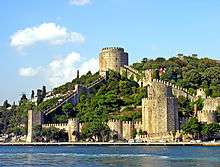Meydancık Castle
| Meydancık Castle | |
|---|---|
| Gülnar, Mersin Province | |
 | |
 Meydancık Castle | |
| Coordinates | 36°19′00″N 33°22′00″E / 36.3166667°N 33.3666667°E |
| Type | Fortress |
| Site information | |
| Open to the public | Yes |
| Site history | |
| Built by | Pirandu (Luwian People) |
| Demolished | Most of it |


Meydancık Castle (Turkish: Meydancık Kale) is the name of a castle ruin in Mersin Province, Turkey. The original name was Kirshu and the name of the ruin during Ottoman times was Beydili Kale.
Geography
The castle is located at 36°19′N 33°22′E / 36.317°N 33.367°E, just south of Gülnar. It is on a 700-metre (2,300 ft) hill at the west of the road between Gülnar and Aydıncık. Visitors can reach the castle either from Gülnar by a 11 kilometres (6.8 mi) road or from Aydıncık by a 35 kilometres (22 mi) road. From Mersin the total distance (via Gülnar) is about 165 kilometres (103 mi).
History
After the collapse of the Hittite Empire, Anatolia experienced a period of turmoil. Many small states emerged, one of which was Pirandu in South Anatolia, which was established by the Luwian people at the west of the Göksu River around the 7th century BC. The capital of Pirandu was Kirshu .[1][2] However, in the 6th century BC, Kirshu was sacked by the Babylon Emperor Neriglissar. After Babylon was defeated by the Persians, Kirshu came under Achaemenid rule and after the Achaemenid Empire was defeated by Alexander III of Macedon, Kirshu was incorporated within the realm of the Ptolemaic dynasty of Egypt [3] and later that of the Seleucid Empire.
The fortification
The plan of the fortification is roughly rectangular, with the longer dimension oriented along a north-south axis. The total area is 750 x 150 m2 (2460 x 490 ft2) In the fortification the military units were at the north side of the hill and the only entrance to castle was via the gate at the north east corner. The palace was at the middle. A public treasure consisting of 5215 coins from various Hellenistic states has been unearthed in the palace. These coins are now exhibited in Silifke Museum. Another important find was a stamp of Muwatalli II,[4] which was surprising because Hittites inhabited the area long before the establishment of Pirundu. At the south there is a wide wellhole, the function of which is debatable. It might either be a cistern or an altar or may even be a secret passage. At the present, excavations down to 23 metres (75 ft) gave no clue.
References
- ↑ Paper about ancient Kelenderis
- ↑ Arik, Osman; Çalışkan, Mehmet; Aydın, Ayşe; Aydınoğlu, Ümit; Kerem, Filiz, eds. (2009) [2007]. Mersin: Ören Yerleri, Kaleleri, Müzeleri [Mersin: Oren Places, Castles, Museums] (in Turkish). Prepared by Filiz Kerem; Photographs by Selami Türk; Graphic design by Tanrtim Sanatlari (First ed.). Istanbul: Ekin Grubu (2007, first edition); İl Özel İdaresi (2009 edition). ISBN 978-605-4196-07-4. OCLC 805652523. ISBN (invalid as printed in first edition) 975-585-787-9. Archived from the original on June 4, 2014.
- ↑ Gülnar Meydancıkkale page (Turkish)
- ↑ Ministry of Culture and Tourism Mersin(Turkish)
